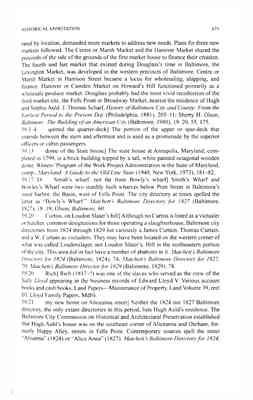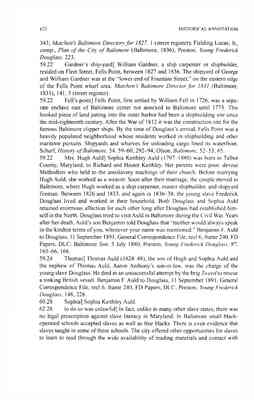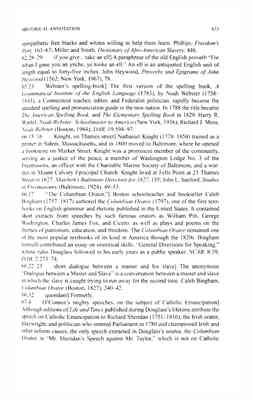Pages
41
HISTORICAL ANNOTATION 669
owned by Edward Lloyd V. Plantation records indicate that Denby, a prime field hand, died sometime during the year 1822. Return Book, 1 January 1822, 1 January 1823, Land Papers--Maintenance of Property, Land Volume 39, reel 10, Lloyd Family Papers, MdHi; Preston, Young Frederick Douglass, 72-73, 213. 53.37-38 St. Michaels] The town of St. Michaels, Talbot County, Maryland, was incorporated in 1805 by the Maryland General Assembly. It is believed to have been established early in the seventeenth century, although the exact date has been debated, one account placing the building of a Reformed Church on that site in 1672. Located on the Miles River, the town became the local place of embarkation for vessels bound for Baltimore. Tilghman, Talbot County, 2:375-77, 381-85. 54.5 Thomas Lambdin] Thomas H. W. Lambdin (c. 1807-?) had labored at a number of trades by 1850; shipwright, schoolteacher, town bailiff for St. Michaels (1848), and miller (1850). In 1850 he was married, had five young children, and owned real estate valued at $1,000. In a rebuttal to Douglass's negative characterization, a Maryland friend described Lambdin as "too good-natured and harmless to injure any person but himself." Thompson, "To the Public--Falsehood Refuted"; Tilghman, Talbot County, 2:395. 54.12 Mrs. Giles Hicks] No court records of this murder have been found. Douglass probably learned of this incident from his wife Anna Murray Douglass who grew up in Caroline County. A Mr. and Mrs. Giles Hicks resided in Caroline County, Maryland, in 1820. 1820 U.S. Census, Maryland, Talbot County, 92; Preston, Young Frederick Douglass, 74. 54.34 Beale Bordley] John Beale Bordley (1800-82) was the son of Matthias Bordley (1757-1828) and the grandson of John Beale Bordley (1727-1804), a noted agriculturalist and Revolutionary War era patriot from Maryland. Often called simply Beale Bordley, John Beale Bordley was born on his father's Wye Island estate, across the river from the Lloyd plantation, and remained there until his mid-twenties, when he moved to Philadelphia to study law with Pennsylvania Chief Justice John Bannister Gibson. Quickly tiring of the law, Bordley developed a very successful career as a portrait painter of prominent figures in Baltimore, Philadelphia, and elsewhere. A number of his paintings are held by the Maryland Historical Society. Baltimore American and Commercial Advertiser, 14 March 1882; Francis Sims McGrath, Pillars of Maryland (Richmond, Va., 1950), 393; idem. "A Letter to Eileen," MdHM, 24:306 (December 1929); Eugenia Calvert Holland and Louisa MacGill Gary, comps., "Miniatures in the Collection of the Maryland Historical Society," MdHM, 51:342, 346, 353 (December 1956); Anna Wells Rutledge, "Portraits Painted before 1900 in the Collection of the Maryland Historical Society," MdHM, 41:35-36, 43 March 1946). 56.16 the good Samaritan] The good Samaritan, mentioned in Luke 10:33, generally refers to a kind and helpful person. Ebenezer Cobham Brewer, ed., Brewer's Dictionary of Phrase and Fable, ed. John Ayto (New York, 2005), 598; Freedman, Anchor Bible Dictionary, 5:149-50.
42
670 HISTORICAL ANNOTATION
56.17 balsam] An aromatic oily or resinous medicinal application, usually for external application, for healing wounds or soothing pain. 56.33 termagant] An overbearing or nagging woman. 57.3-4 sack-cloth] Coarse textile used for bags or for wrapping bales. 58.1 Hugh Auld] Born in Talbot County, Maryland, Hugh Auld (1799-1861) moved to Baltimore as a young man. There he worked as a ship carpenter, master shipbuilder, and shipyard foreman, and occasionally served as a magistrate. Prior to moving to Baltimore, Hugh married Sophia Keithley. From 1826 to 1833 and again from 1836 to 1838, the young Frederick Douglass lived and worked in their household, lent to them by his owner, Hugh's brother Thomas. In 1845, Hugh, incensed by Douglass's depiction of his family in the Narrative, bought Douglass, then on a lecture tour of Britain, from his brother Thomas. According to the Pennsylvania Freeman, Auld was determined to reenslave Douglass and "'place him in the cotton fields of the South" if the fugitive ever returned to the United States. In 1846 two British abolitionists, Anna and Ellen Richardson, offered to buy Douglass from Auld; in exchange for $711.66 (£150 sterling) raised among British reformers. Auld signed the manumission papers that made Douglass a free man. Walter Lourie to Ellis Gray Loring, 15 December 1846, General Correspondence File, reel 1, frame 644, Benjamin F. Auld to Douglass, 11, 27 September 1891, General Correspondence File, reel 6, frames 240-41, 257-58, Douglass to Benjamin F. Auld, 16 September 1891, General Correspondence File, reel 6, frames 246-47, J. C. Schaffer to Helen Pitts Douglass, 21 October 1896, General Correspondence File, reel 8, frames 92-93, all in FD Papers, DLC; Talbot County Records, V.60, 35-36, 30 November 1846, MdTCH (a copy is found on reel 1, frames 637-39, FD Papers, DLC); Hugh Auld Family Genealogical Chart, prepared by Carl G. Auld, Ellicott City, Md., 5 June 1976; PaF, 26 February 1846; Lib., 6 March 1846; Preston, Young Frederick Douglass, 81, 84-85, 92, 143, 173-75. 58.21 Tom] Tom Bailey (1814-?), the fourth of Milly Bailey's seven children and Douglass's cousin, was a slave belonging to Aaron Anthony. When Anthony died in 1826, Bailey became the property of Thomas Auld. Auld granted Bailey his freedom in 1845. The last record of Bailey's existence is a letter to Douglass from his son Lewis, who visited Talbot County in 1865. During his visit, Lewis wrote, he met with Bailey, who was still living in St. Michaels. Lewis Douglass to Douglass, 9 June 1865, FD Papers, DHU-MS; Aaron Anthony Slave Distribution, 22 October 1827, Talbot County Distributions, V.JP#D, 58-59, MdTCH; Preston, Young Frederick Douglass, 91, 174, 206, 221, 230. 58.31 sixpence] In Britain sixpence is a coin equivalent to six pennies. 58.32-33 shooting-crackers] Probably firecrackers. 58.35 Market house] Baltimore's first market house, though planned in 1751, was not completed until 1763. For the next twenty years, the market house in Baltimore at the comer of Gay and Baltimore Streets was the sole point of activity for provisions commerce. At that point the growing population, diverse in class and separated
43
HISTORICAL ANNOTATION 671
by location, demanded more markets to address new needs. Plans for three new markets followed. The Centre or Marsh Market and the Hanover Market shared the proceeds of the sale of the grounds of the first market house to finance their creation. The fourth and last market that existed during Douglass's time in Baltimore, the Lexington Market, was developed in the western precincts of Baltimore Centre or Marsh Market in Harrison Street became a locus for wholesaling, shipping, and finance. Hanover or Camden Market on Howard's Hill functioned primarily as a wholesale produce market. Douglass probably had the most vivid recollection of the third market site, the Fells Point or Broadway Market, nearest the residence of Hugh and Sophia Auld. J. Thomas Scharf, History of Baltimore City and County: From the Earliest Period to the Present Day (Philadelphia, 1881), 205-11; Sherry H. Olson, Baltimore: The Building of an American City (Baltimore, 1980), 19-20, 55, 175. 59.3-4 quitted the quarter-deck] The portion of the upper or spar-deck that extends between the stern and aftermast and is used as a promenade by the superior officers or cabin passengers. 59.13 dome of the State house] The state house at Annapolis, Maryland, completed in 1799, is a brick building topped by a tall, white-painted octagonal wooden dome. Writers' Program of the Work Project Administration in the State of Maryland, comp., Maryland: A Guide to the Old Line State (1940; New York, 1973), 181-82. 59.17-18 Smith's wharf, not far from Bowly's wharf] Smith's Wharf and Bowley's Wharf were two sturdily built wharves below Pratt Street in Baltimore's inner harbor, the Basin, west of Fells Point. The city directory at times spelled the latter as "Bowly's Wharf." Matchett's Baltimore Directory for 1827 (Baltimore, 1827), 18-19; Olson, Baltimore, 60. 59.20 Curtiss, on Loudon Slater's hill] Although no Curtiss is listed as a victualer or butcher, common designations for those operating a slaughterhouse, Baltimore city directories from 1824 through 1829 list variously a James Curtain, Thomas Curtain, and a W. Curtain as victualers. They may have been located on the western corner of what was called Loudenslager, not Loudon Slater's, Hill in the northeastern portion of the city. This area did in fact have a number of abattoirs in it. Matchett's Baltimore Directory for 1824 ( Baltimore, 1824), 74; Matchett's Baltimore Directory for 1827, 70; Matchett's Baltimore Directory for 1829 (Baltimore, 1829), 78. 59.20 Rich] Rich (1817-?) was one of the slaves who served as the crew of the Sally Lloyd appearing in the business records of Edward Lloyd V. Various account books and cash books, Land Papers--Maintenance of Property, Land Volume 39, reel 10, Lloyd Family Papers, MdHi. 59.21 my new home on Aliceanna street] Neither the 1824 nor 1827 Baltimore directory, the only extant directories in this period, lists Hugh Auld's residence. The Baltimore City Commission on Historical and Architectural Preservation established that Hugh Auld's house was on the southeast corner of Aliceanna and Durham, formerly Happy Alley, streets in Fells Point. Contemporary sources spell the street "Alisanna" (1824) or "Alice Anna" (1827). Matchett's Baltimore Directory for 1824,
44
672 HISTORICAL ANNOTATION
343; Matchett's Baltimore Directory for 1827, 1 (street register); Fielding Lucas, Jr., comp., Plan of the City of Baltimore ( Baltimore, 1836); Preston, Young Frederick Douglass, 223.
59.22 Gardner's ship-yard] William Gardner, a ship carpenter or shipbuilder, resided on Fleet Street, Fells Point, between 1827 and 1836. The shipyard of George and William Gardner was at the "lower end of Fountain Street," on the eastern edge of the Fells Point wharf area. Matchett's Baltimore Director for 1831 (Baltimore, 1831), 141, 5 (street register).
59.22 Fell's point] Fells Point, first settled by William Fell in 1726, was a separate enclave east of Baltimore center not annexed to Baltimore until 1773. This hooked piece of land jutting into the outer harbor had been a shipbuilding site since the mid-eighteenth century. After the War of 1812 it was the construction site for the famous Baltimore clipper ships. By the time of Douglass's arrival, Fells Point was a heavily populated neighborhood whose residents worked in shipbuilding and other maritime pursuits. Shipyards and wharves for unloading cargo lined its waterfront. Scharf, History of Baltimore, 54, 59-60, 292-94; Olson, Baltimore, 52-53, 85.
59.22 Mrs. Hugh Auld] Sophia Keithley Auld (1797-1880) was born in Talbot County, Maryland, to Richard and Hester Keithley. Her parents were poor, devout Methodists who held to the antislavery teachings of their church. Before marrying Hugh Auld, she worked as a weaver. Soon after their marriage, the couple moved to Baltimore, where Hugh worked as a ship carpenter, master shipbuilder, and shipyard fireman. Between 1826 and 1833, and again in 1836-38. the young slave Frederick Douglass lived and worked in their household. Both Douglass and Sophia Auld retained enormous affection for each other long after Douglass had established himself in the North. Douglass tried to visit Auld in Baltimore during the Civil War. Years after her death, Auld 's son Benjamin told Douglass that "mother would always speak in the kindest terms of you, whenever your name was mentioned." Benjamin F. Auld to Douglass, 11 September 1891, General Correspondence File, reel 6, frame 240, FD Papers, DLC; Baltimore Sun, 5 July 1880; Preston, Young Frederick Douglass, 87, 165-66, 168.
59.24 Thomas] Thomas Auld (1824-48), the son of Hugh and Sophia Auld and the nephew of Thomas Auld, Aaron Anthony's son-in-law. was the charge of the young slave Douglass. He died in an unsuccessful attempt by the brig Tweed to rescue a sinking British vessel. Benjamin F. Auld to Douglass, 11 September 1891, General Correspondence File, reel 6, frame 240, FD Papers, DLC; Preston, Young Frederick Douglass, 148, 228.
60.28 Sophia] Sophia Keithley Auld.
62.28 to do so was unlawful] In fact, unlike in many other slave states, there was no legal proscription against slave literacy in Maryland. In Baltimore small blackoperated schools accepted slaves as well as free blacks. There is even evidence that slaves taught in some of these schools. The city offered other opportunities for slaves to learn to read through the wide availability of reading materials and contact with
45
HISTORICAL ANNOTATION 673
sympathetic free blacks and whites willing to help them learn. Phillips, Freedom's Port, 163-67; Miller and Smith, Dictionary of Afro-American Slavery, 446.
62.28-29 if you give. . .take an ell] A paraphrase of the old English proverb "For whan I gaue you an ynche, ye tooke an ell." An ell is an antiquated English unit of length equal to forty-five inches. John Heywood, Proverbs and Epigrams of John Heywood (1562; New York, 1967), 78.
65.23 Webster's spelling-book] The first version of the spelling book, A Grammatical Institute of the English Language (1783), by Noah Webster (17581843), a Connecticut teacher, editor, and Federalist politician, rapidly became the standard spelling and pronunciation guide in the new nation. In 1788 the title became The American Spelling Rook, and The Elementary Spelling Book in 1829. Harry R. Warfel, Noah Webster, Schoolmaster to America (New York, 1936); Richard J. Moss, Noah Webster (Boston, 1984); DAB, 19:594-97.
66.15-16 Knight, on Thames street] Nathaniel Knight (1778-1854) trained as a printer in Salem, Massachusetts, and in 1800 moved to Baltimore, where he opened a bookstore on Market Street. Knight was a prominent member of the community, serving as a justice of the peace, a member of Washington Lodge No. 3 of the Freemasons, an officer with the Charitable Marine Society of Baltimore, and a warden in Mount Calvary Episcopal Church. Knight lived at Fells Point at 23 Thames Street 1827. Matchett's Baltimore Directory for 1827, 155; John L. Sanford, Studies in Freemasonry (Baltimore,1924), 49-53.
66.17 "The Columbian Orator."] Boston schoolteacher and bookseller Caleb Bingham (1757-1817) authored the Columbian Orator (1797), one of the first textbooks on English grammar and rhetoric published in the United States. It contained short extracts from speeches by such famous orators as William Pitt, George Washington, Charles James Fox, and Cicero, as well as plays and poems on the themes of patriotism, education, and freedom. The Columbian Orator remained one of the most popular textbooks of its kind in America through the 1820s. Bingham himself contributed an essay on oratorical skills. "General Directions for Speaking," whose rules Douglass followed in his early years as a public speaker. NCAB, 8:19; DAB, 2:273-74.
66.22-23 short dialogue between a master and his slave] The anonymous "Dialogue between a Master and Slave" is a conversation between a master and slave in which the slave is caught trying to run away for the second time. Caleb Bingham, Columbian Orator ( Boston, 1827), 240-42.
66.32 quondam] Formerly.
67.4 O'Connor's mighty speeches,on the subject of Catholic Emancipation] Although editions of Life and Times published during Douglass's lifetime attribute the speech on Catholic Emancipation to Richard Sheridan (1751-1816), the Irish orator, playwright, and politician who entered Parliament in 1780 and championed Irish and other reform causes, the only speech extracted in Douglass's source, the Columbian Orator, is "Mr. Sheridan's Speech against Mr. Taylor," which is not on Catholic




